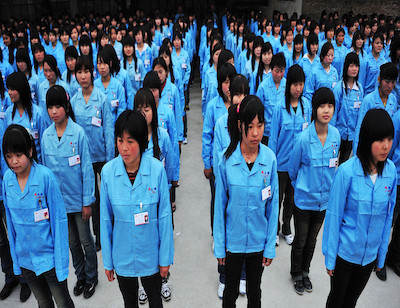
The ABCs of Trade: If It Can’t Be Made in America, It Should Be Made Anywhere But China
Tariffs are depriving Beijing of money it needs to expand brutal regime
The annual 2019 trade figures for the United States came out last week , heralding some encouraging news. America’s enormous international trade deficit actually declined slightly from 2018. This was the first decrease in six years, with the deficit in goods and services dropping 1.7%, to $616.8 billion.
Better yet, America’s bilateral trade deficit with China fell for the first time in four years, dropping a hefty 17.6%, to $345.6 billion.
These are promising numbers and they show that tariffs on Chinese products are successfully moving the needle on U.S. trade flows. In fact, America’s 2019 imports from China actually fell $87.4 billion from the all-time high set in 2018.
At the same time, America’s trade deficits with other competitors did increase in 2019. The U.S. goods deficit with the EU rose 5.4%. The deficit with Mexico climbed 26.2%. And the deficit with Canada increased 41.9%.
Overvalued dollar
Companies like mine — that manufacture goods in America’s industrial heartland—would like to see these trade deficits begin to decline as well. But that will require more than just tariff action, since
America’s overvalued dollar
BUXX,
Clearly, though, economists were wrong in predicting that tariffs would kill global trade, increase inflation, or cause a recession. My company, which competes directly with China in fabricated metal parts and assemblies, has seen firsthand that the tariffs are helping domestic industry.
There are two key justifications for the tariffs.
First, they’re providing relief for domestic companies like mine that have suffered from subsidized import competition. America’s steel companies are currently investing some $13 billion in new steelmaking across the nation. That investment is creating higher-paying jobs in rural areas.
Advanced industries are seeing benefits as well. Roughly a dozen solar manufacturers are now investing in U.S.-based production First Solar, FSLR, -3.21% for example, has announced a $1 billion facility in Ohio that’s expected to create 500 jobs.
Geopolitical strategy
Second, the tariffs underpin an important geopolitical strategy. Now that Beijing has become a major strategic competitor —and is making a bid for global hegemony—the tariffs can help to reduce the trade profit that keeps driving China’s rise.
With the tariffs underway, the United States should pursue an “ABC” strategy: “Anywhere But China.” The tariffs are already helping to drive production out of China and into other countries. That’s a good thing. But in order to constrain China’s rise, the United States should continue to encourage manufacturing to move away from mainland China.
Since 2001, the United States has suffered trillions of dollars in cumulative trade debt with Beijing. That has cost an estimated 3.7 million U.S. jobs and reduced the quality of employment in America’s workforce.
At the same time, the United States has become progressively more reliant on China for prescription drugs , key industrial metals , and military hardware . And Chinese companies brazenly hack U.S. steel companies and wind turbine manufacturers while Chinese agents steal America’s research in biomedical science, wireless technology, and aerospace engineering.
Predatory trade
China happily uses this predatory trade to fund a brutal regime that persecutes religious and ethnic minorities. It also uses forced labor to boost manufacturing output. It rarely enforces weak labor standards. And lax environmental regulations have allowed Chinese factories to continue releasing ozone-depleting carbon tetrachloride into the atmosphere, in violation of international agreement.
In the face of such wanton behavior, the United States should do everything possible to limit China’s rise. That in itself would justify tariffs on Chinese exports. “Anywhere but China” should be the overriding approach as the United States reduces its dependence on China and encourages increased production at home.
If something can’t be manufactured in the United States, it should be made somewhere other than in China. That common-sense approach should be the “ABC” of future U.S. geopolitical strategy.
© Author: Zach Mottl
